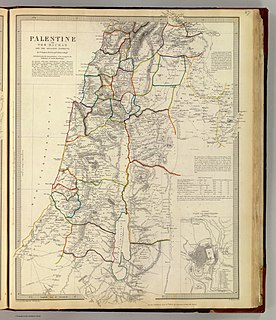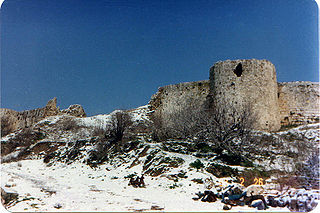Related Research Articles

Fakhr al-Din ibn Qurqumaz Ma'n, commonly known as Fakhr al-Din II or Fakhreddine II, was the paramount Druze emir of Mount Lebanon from the Ma'n dynasty, an Ottoman governor of Sidon-Beirut and Safed, and the strongman over much of the Levant from the 1620s to 1633. For uniting modern Lebanon's constituent parts and communities, especially the Druze and the Maronites, under a single authority for the first time in history, he is generally regarded as the country's founder. Although he ruled in the name of the Ottomans, he acted with considerable autonomy and developed close ties with European powers in defiance of the Ottoman imperial government.

Jabal Amil, also spelled Jabal Amel and historically known as Jabal Amila, is a cultural and geographic region in Southern Lebanon largely associated with its long-established, predominantly Twelver Shia Muslim inhabitants. Its precise boundaries vary, but it is generally defined as the mostly highland region on either side of the Litani River, between the Mediterranean Sea in the west and the Wadi al-Taym, Beqaa and Hula valleys in the east.

The Eyalet of Sidon was an eyalet of the Ottoman Empire. In the 19th century, the eyalet extended from the border with Egypt to the Bay of Kisrawan, including parts of modern Israel and Lebanon.

Beaufort or Belfort Castle, known locally as Qal'at al-Shaqif or Shaqif Arnun, is a Crusader fortress in Nabatieh Governorate, Southern Lebanon, about 1 kilometre (0.62 mi) to the south-south-east of the village of Arnoun. There was a fortification on the site before it was captured by Fulk, King of Jerusalem, in 1139 and construction of the Crusader castle probably began soon after. Saladin captured Beaufort in 1190, but 60 years later Crusaders re-took it. In 1268 Sultan Baibars finally captured the castle for the Islamic forces.
The Battle of Ain Dara took place in the town of Ain Dara in 1711 between the Qaysi and Yamani tribo-political factions. The Qays were led by Emir Haydar of the Shihab dynasty and consisted of the Druze clans of Jumblatt, Talhuq, Imad and Abd al-Malik and the Maronite clan of Khazen. The Yamani faction was led by Mahmoud Abu Harmoush and consisted of the Druze Alam al-Din, Arslan and Sawaf clans. The Yamani faction also had backing from the Ottoman provincial authorities of Sidon and Damascus. The battle ended in a rout of the Yamani faction and resulted in the consolidation of Qaysi political and fiscal domination over Mount Lebanon. The battle's outcome also precipitated a mass migration of pro-Yamani Druze nobility and peasants from Mount Lebanon to the eastern Hauran, in a mountainous area today known as Jabal al-Druze.

The Shihab dynasty was an Arab family whose members served as the paramount tax farmers and local chiefs of Mount Lebanon from the early 18th to mid-19th century, during Ottoman rule. Their reign began in 1697 after the death of the last Ma'nid chief. The family centralized control over Mount Lebanon, destroying the feudal power of the mostly Druze lords and cultivating the Maronite clergy as an alternative power base of the emirate. The Shihab family allied with Muhammad Ali of Egypt during his occupation of Syria, but was deposed in 1840 when the Egyptians were driven out by an Ottoman-European alliance, leading soon after to the dissolution of the Shihab emirate. Despite losing territorial control, the family remains influential in modern Lebanon, with some members having reached high political office.

The Ma'n dynasty, also known as the Ma'nids;, were a family of Druze chiefs of Arab stock based in the rugged Chouf area of southern Mount Lebanon who were politically prominent in the 15th–17th centuries. Traditional Lebanese histories date the family's arrival in the Chouf to the 12th century, when they were held to have struggled against the Crusader lords of Beirut and Sidon alongside their Druze allies, the Tanukh Buhturids. They may have been part of a wider movement by the Muslim rulers of Damascus to settle militarized Arab tribesmen in Mount Lebanon as a buffer against the Crusader strongholds along the Levantine coast. Fakhr al-Din Uthman ibn Yunus Ma'n, the first member of the family whose historicity is certain, was the "emir of the Chouf", according to contemporary sources and, despite the non-use of mosques by the Druze, founded the Fakhreddine Mosque in the family's stronghold of Deir al-Qamar.
Mulhim ibn Yunus Ma'n was the paramount Druze emir of Mount Lebanon and head of the Ma'n dynasty after succeeding his uncle Fakhr al-Din II in 1633. The Ottomans executed Fakhr al-Din, Mulhim's father Yunus, and his brothers and cousins during and after a massive expedition to end their control over large parts of the Levant. After Mulhim defeated his principal Druze rival, Ali Alam al-Din, in 1641, the Ottomans granted him tax farms previously held by his uncle and father Yunus in southern Mount Lebanon, namely for the subdistricts of the Chouf, Gharb, Matn and Jurd. In 1657 he was appointed governor and tax farmer of Safed. He held onto the tax farms of southern Mount Lebanon until his death in 1658, after falling ill attempting to collect taxes in Safed.

The Emirate of Mount Lebanon was a part of Mount Lebanon that enjoyed variable degrees of partial autonomy under the stable suzerainty of the Ottoman Empire between the mid-16th and the early-19th century.
The Druze power struggle of 1658–1667 was one of the most violent episodes of tribal disputes during Ottoman rule in the Levant. The conflict erupted between rebel and pro-Ottoman Druze factions over succession of the Maani rule.

The Harfush dynasty was a dynasty that originated from the Khuza'a tribe, which helped, under the reign of Muhammad, in the conquest of Syria. The Harfush dynasty was in control of the Baalbek District and several parts of the Bekaa Valley. The religion they praised was a huge factor to the rivalry between the Harfushes and the Lebanese Druze Maan family.
Nasif ibn al-Nassar al-Wa'ili was the most powerful sheikh of the rural Shia Muslim (Matawilah) tribes of Jabal Amil in the mid-18th century. He was based in the town of Tebnine and was head of the Ali al-Saghir clan. Under his leadership, the Jabal Amil prospered, due largely to the revenues from dyed cotton cloth exports to European merchants.
Yusuf Shihab (1748–1790) was the autonomous emir of Mount Lebanon between 1770 and 1789. He was the fifth consecutive member of the Shihab dynasty to govern Mount Lebanon.

Safed Sanjak was a sanjak (district) of Damascus Eyalet in 1517–1660, after which it became part of the Sidon Eyalet. The sanjak was centered in Safed and spanned the Galilee, Jabal Amil and the coastal cities of Acre and Tyre. The city of Safed was made up of Muslim and Jewish townspeople, while the rest of the sanjak was populated by Sunni Muslims, Jewish peasants, Bedouin tribesmen, Shia Muslims and Druze peasants.
Mansur Bey ibn Furaykh was Emir of the Biqa'a, Safad and Ajlun districts in the late 16th century during Ottoman rule. The Ottomans granted Mansur this large power base to enable him to check the growing power of rebellious Lebanese clans, namely the Ma'an and Harfush. However, complaints were lodged against him alleging that he oppressed his subjects, and killed and robbed wealthy Muslim pilgrims during his service as amir al-hajj. Mansur also failed to pay the Ottoman authorities the taxes they were due from his sanjaks. Because of these actions, Mansur was arrested and executed.
Arslan Mehmed Mataraci Pasha, also Arslan Muhammad Pasha ibn al-Mataraji, was the wali of Tripoli in 1694–1700 and 1702–1703, Damascus in 1701 and Sidon in 1703–1704.
The 1585 Ottoman expedition against the Druze, also called the 1585 Ottoman invasion of the Shuf, was an Ottoman military campaign led by Ibrahim Pasha against the Druze and other chieftains of Mount Lebanon and its environs, then a part of the Sidon-Beirut Sanjak of the province of Damascus Eyalet. It had been traditionally considered the direct consequence of a raid by bandits in Akkar against the tribute caravan of Ibrahim Pasha, then Egypt's outgoing governor, who was on his way to Constantinople. Modern research indicates that the tribute caravan arrived intact and that the expedition was instead the culmination of Ottoman attempts to subjugate the Druze and other tribal groups in Mount Lebanon dating from 1518.
The Alam al-Dins, also spelled Alamuddin or Alameddine, were a Druze family that intermittently held or contested the paramount chieftainship of the Druze districts of Mount Lebanon in opposition to the Ma'n and Shihab families in the late 17th–early 18th centuries during Ottoman rule. Their origins were obscure with different accounts claiming or proposing Tanukhid or Ma'nid ancestry. From at least the early 17th century they were the traditional leaders of the Yaman faction among the Druzes, which stood in opposition to the Qays, led by the Tanukhid Buhturs, traditional chiefs of the Gharb area south of Beirut, and the Ma'ns. A likely chief of the family, Muzaffar al-Andari, led the Druze opposition to the powerful Ma'nid leader Fakhr al-Din II until reconciling with him in 1623.

El-Assaad or Al As'ad is a feudal political family/clan originally from Najd and a main branch of the anza tribe. Unrelated to Syrian or Palestinian Al-Assads, El-Assaad dynasty that ruled most of South Lebanon for three centuries and whose lineage defended fellow denizens of history's Jabal Amel principality – today southern Lebanon – for 36 generations, Balqa in Jordan, Nablus in Palestine, and Homs in Syria governed by Ottoman rule between generations throughout the Arab caliphate by Sheikh al Mashayekh Nasif Al-Nassar ibn Al-Waeli, Ottoman conquest under Shbib Pasha El Assaad, Ali Bek El Assaad ruler of Belad Bechara, Ali Nassrat Bek. Advisor of the Court and a Superior in the Ministry of Foreign affairs in the Ottoman Empire, Moustafa Nassar Bek El Assaad Supreme Court President of Lebanon and colonial French administration by Hassib Bek—also supreme court Judge and grand speaker at halls across the Levant. El-Assaads are considered now "Bakaweit", and are considered princes or heirs to the family's dynasty to some.
Aḥmad ibn Mulḥim ibn Yunus Maʾn was the paramount emir of the Druze in Mount Lebanon and the tax farmer of the subdistricts of the Chouf, Matn, Gharb and Jurd from 1667 until his death in 1697. He was the last member of the Ma'n dynasty, after which paramount leadership passed to his marital relatives from the Shihab dynasty.
References
- ↑ Winter 2010, p. 124.
- ↑ Winter 2010, p. 125.
- ↑ Winter 2010, pp. 126, 128.
- ↑ Winter 2010, p. 129.
- ↑ Winter 2010, p. 130.